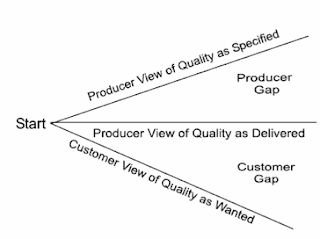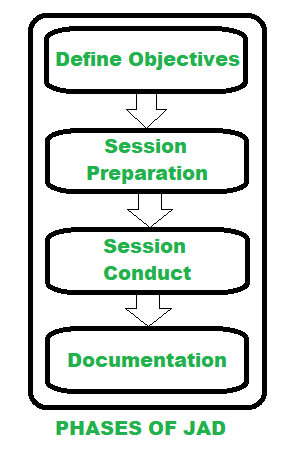
- Jad Sessions Definition Series Of Collaborative#
- Jad Sessions Definition Software Development Analysis#
Personal interviews are time consuming and subject to error, and their data are prone to misinterpretation. Mempersiapkan sesi JAD seperti agenda, perangkat bantu dan mengembangkan bahan-bahan pertemuan Session.No matter how adept you become as an interviewer, you will inevitably experience situations in which one-on-one interviews do not seem to be as useful as you would like. Penelitian didasarkan pada user requirements Preparation. Menentukan tujuan & lingkup projek, kendala-kendala projek, dan project team Research. Tahap-Tahap pada Joint Application Development (JAD) Project Definition.
Jad Sessions Definition Series Of Collaborative
Although JAD can be substituted for personal interviews at any appropriate juncture during the SDLC, it has usually been employed as a technique that allows you, as a systems analyst, to accomplish requirements analysis and to design the user interface jointly with users in a group setting. Two employees of IBM, Chuck Morris and Tony Crawford, developed the JAD methodology in the late 1970s and began teaching the. This is accomplished through a series of collaborative workshops called JAD sessions. The proposed system will provide moreThe Joint Application Development (JAD) methodology aims to involve the client in the design and development of an application. The motivation for using JAD is to cut the time (and hence the cost) required by personal interviews, to improve the quality of the results of information requirements assessment, and to create more user identification with new information systems as a result of the participative processes.JAD Session Situation: The JAD team wants you to draw up a checklist of requirements for the new inventory system.
Jad Sessions Definition Software Development Analysis
Chuck Morris and Tony Crawford, both of IBM, developed Jad in the late 1970s and began teaching the approach through workshops in 1980. Are presented in joint application development (JAD) sessions to a select group of.Jad (Joint Application Development) is a methodology that involves the client or end user in the design and development of an application, through a succession of collaborative workshops called Jad sessions. Conditions That Support the Use of JADDefinition Phase: systems analysis and software development analysis. We can, however, convey enough information about JAD here to make you aware of some of its benefits and drawbacks in comparison with one-on-one interviews.
The organizational culture supports joint problem-solving behaviors among multiple levels of employees. User groups are restless and want something new, not a standard solution to a typical problem. Consider using joint application design when: One of the leading methodologies for user involvement and proach, and discuss our observations of JAD sessions for The following list of conditions will help you decide when the use of JAD may be fruitful.
Preferably, select an executive from the user group who has some sort of authority over the IS people working on the project. Choose an executive sponsor, a senior person who will introduce and conclude the JAD session. Your primary concern here is that all project team members are committed to the JAD approach and become involved. Organizational workflow permits the absence of key personnel during a two-to-four-day block of time.Joint application design sessions include a variety of participants—analysts, users, executives, and so on—who will contribute differing backgrounds and skills to the sessions.
Without this kind of immediate feedback, unrealistic solutions with excessive costs may creep into the proposal and prove costly to discourage later on.From eight to a dozen users can be chosen from any rank to participate in JAD sessions. In addition, you will want to give an expert opinion about any disproportionate costs of solutions proposed during the JAD session itself. As the project analyst, you should be present during JAD to listen to what users say and what they require.
In addition, one scribe from the IS department should attend the JAD sessions to formally write down everything that is done. The point is to get a person who can bring the group’s attention to bear on important systems issues, satisfactorily negotiate and resolve conflicts, and help group members reach a consensus.Your JAD session should also include one or two observers who are analysts or technical experts from other functional areas to offer technical explanations and advice to the group during the sessions. To avoid this possibility, an organization may want to retain an outside management consultant to serve as session leader. Note that you do not want to use a session leader who reports to another person in the group.
The room itself should comfortably hold the number of people invited. The idea is to minimize the daily distractions and responsibilities of the participants’ regular work. Some groups use executive centers or even group decision support facilities that are available at major universities.
Such a premeeting allows you to move rapidly and act confidently once the actual meeting is convened. Ensure that all participants receive an agenda before the meeting, and consider holding an orientation meeting for a half day one week or so before the workshop so that those involved know what is expected of them. This rule is critical to the success of the sessions. Do not hold the sessions unless everyone who has been invited can actually attend. Group decision support rooms will also provide networked PCs, a projection system, and software written to facilitate group interaction while minimizing unproductive group behaviors.Schedule your JAD session when all participants can commit to attending.
The first potential benefit is time savings over traditional one-on-one interviews. Potential Benefits of Using JAD in Place of Traditional InterviewingThere are four major potential benefits that you, the users, and your systems analysis team should consider when you weigh the possibilities of using joint application design. Specifics of the system, including details on screen and report layouts, should also be included. Systematically present the management objectives as well as the scope and boundaries of the project. Clearly, ad hoc interactive systems such as decision support systems and other types of systems dependent on decision-maker style (including prototype systems) are not as easily analyzed with the structured approach of JAD.As the analyst involved with the JAD sessions, you should receive the notes of the scribe and prepare a specifications document based on what happened at the meeting. For each topic, the questions who, what, how, where, and why should also be asked and answered.





 0 kommentar(er)
0 kommentar(er)
